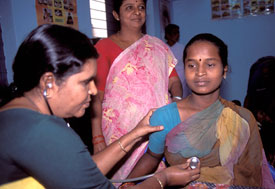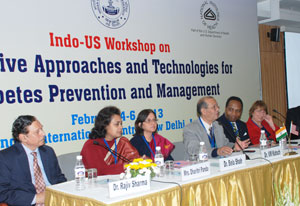US and India advance diabetes research plans
March / April 2013 | Volume 12, Issue 2

Photo by John Isaac/World Bank
There are over 50 million diabetics in India
alone, making it the country with the highest
burden of diabetes worldwide. Government
awareness of the problem has increased,
thanks in part to a Fogarty-funded research
training program.
Researchers in the U.S. and India are joining forces against a growing health problem in their countries, diabetes and related diseases. An NIH delegation of 15 academic and government scientists recently attended a three-day meeting with counterparts in India to discuss scientific collaborations. The activity is the result of an agreement signed by the top Indian and U.S. health officials in June 2012 that aims to accelerate joint research in this field.
Under the new initiative, the NIH's National Institute of Diabetes and Digestive and Kidney Diseases (NIDDK) and India's two main research agencies - the Indian Council of Medical Research and the Department of Biotechnology - will support a parallel funding program to fund a joint diabetes research agenda.
"Both the United States and India have a vested interest in improving our understanding of and treatment for diabetes, and in finding economic ways to do both," said NIDDK Director Dr. Griffin P. Rodgers, welcoming this first partnership between his agency and India.

Photo courtesy of the Indian Council of Medical Research
Delegates from the U.S. and India flesh out plans
to jointly research diabetes, a rising problem in
both countries.
"This research relationship will enable both countries to share expertise and engage each other in research to lessen the burden of diabetes ... around the world," Rodgers said.
Over the years, India and the NIH, with guidance from Fogarty, have nurtured many research partnerships, for instance in eye diseases, addictive disorders, mental health, muscular diseases and stroke. "Our two countries have a long tradition of advancing research together and we welcome this new initiative that focuses on a health area of high importance in both our populations," said Fogarty Director Dr. Roger I. Glass, who also attended the recent meeting in New Delhi and has partnered with Indian colleagues for many years in studying rotavirus.
As with the U.S., India faces alarming increases in Type 2 diabetes and related conditions, such as cardiovascular disease, kidney failure and adult-onset blindness. About 24 million Americans and 61 million Indians have diabetes, according to the International Diabetes Federation.
Researchers aim to illuminate, for instance, why individuals of South Asian origin develop diabetes at a lower body mass index and waist circumference than do people from elsewhere. The findings will be relevant for many Americans, given the population's diverse make-up.
More Information
To view Adobe PDF files,
download current, free accessible plug-ins from Adobe's website.